Thanks to everyone who visited the site this year. I'm sorry for the lack of updates in recent weeks, but I've just been terribly busy and tired. I hope to do better in 2010.
A special thanks to Mark Carwardine, Stephen Fry and producer Tim Green, for bringing Last Chance To See back to the BBC. It was a truly splendid and spectacular series, and I thoroughly enjoyed it.
Paternity tests by the Department of Conservation have confirmed that two of the 33 Kakapo chicks hatched in 2009 were conceived after artificial insemination of the females. The Southland Times has the story.
DOC kakapo recovery manager Deidre Vercoe said infertility had been a big problem and this was a significant breakthrough.2009 was such a fabulous year for the Kakapo, but it looks like 2010 won't be quite as prosperous.
[...]
Six female kakapo were artificially inseminated using different sperm storage techniques. Sperm collected and refrigerated for two to five hours before insemination was the most successful method, resulting in two female chicks.
There was little rimu fruit ripening this year and the birds were not expected to breed.
2010 kommer bli bra!
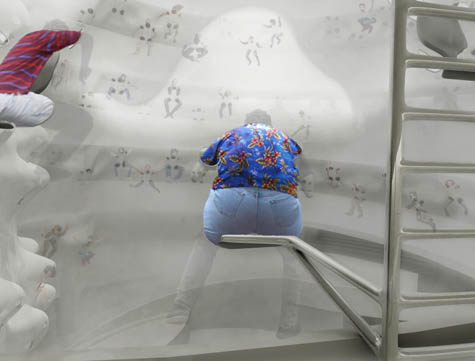 [Image: From Art Trap by Minsuk Cho].
[Image: From Art Trap by Minsuk Cho].
In an amazing response to the Guggenheim Museum's Contemplating the Void call-for-ideas (mentioned in the previous post), architect Minsuk Cho has proposed Art Trap.
Explaining their approach, the architects write that "the Guggenheim has become, in a sense, a victim of its own success due to an over-saturation of human movement in a singular space. Our proposal aims to accomplish the seemingly incompatible: to restore a museum environment conducive to experiencing art and to maximize and heighten other experiences brought about by the iconic status of the museum itself."
The specific strategy here is "to trap, i.e., to force a pause. This programmatic component was not considered by Wright, who envisioned a space defined by tireless motion." 
 [Images: From Art Trap by Minsuk Cho].
[Images: From Art Trap by Minsuk Cho].
The resulting project is a gigantic membrane stretched throughout the interior, supplying "180 saddle-like seats along the entire ramp for pausing and viewing the rotunda."
- These seats protrude into the void with access ladders arranged in between the floor and the ceiling over the guardrails. Each of the 90 access ladders holds two cantilevering seats, which are angled gradually as they ascend to allow a view of the central area at ground level that functions almost like a stage—as though the rotunda were a new hybrid of opera house and arena. The 180 protrusions over the void are draped with a single, soft and translucent membrane that functions as a safety net.
 [Image: From Art Trap by Minsuk Cho].
[Image: From Art Trap by Minsuk Cho].The architects continue, writing that "the pop-out pods, each approximately 60 cm deep, contain seats," and "each pod has five openings for the head and limbs, which make the membrane"—and I love this metaphor—"much like a garment that can be worn collectively by 180 people."
Imagining a piece of clothing so huge you mistake for a building is an awesome change in both scale and context; you would go inside by putting the building on, slipping in one arm at a time.
Of course, this also raises the possibility of tailoring clothing specifically to function only within certain very specific architectural structures: nylon tights that only make sense to wear when seated in one of Cho's "pop-out pods," or sweaters that allow you to experience the spatial extravagance of luxury elevators at a new W Hotel in London. You and some friends zip yourselves up into the wall, forming a new private room that would otherwise not be there.
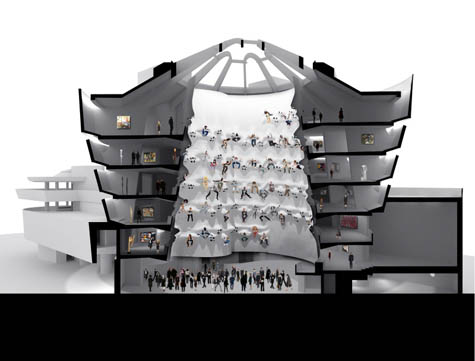 [Images: From Art Trap by Minsuk Cho].
[Images: From Art Trap by Minsuk Cho].But Cho saves the best analogy for last: once the overflowing crowds of art-drunk tourists come to fill the "pop-out pods," it "as if they were performing as a part of a living Baroque ceiling sculpture."
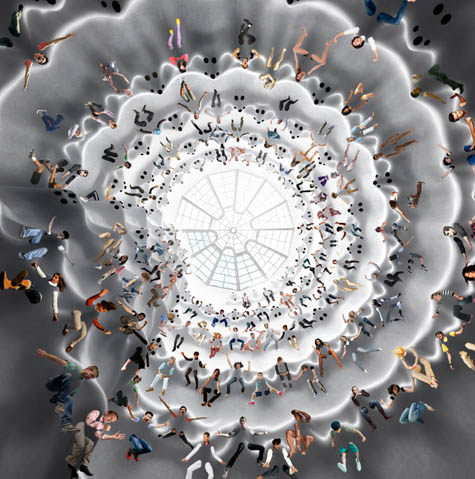 [Image: From Art Trap by Minsuk Cho].
[Image: From Art Trap by Minsuk Cho].I had the pleasure of seeing Cho present this project in person at a lecture he gave back in October at Columbia University; this was the project with which he kicked-off the evening, and it set a fantastically giddy tone for the rest of Mass Studies' work.
You can see this and other projects at the forthcoming Contemplating the Void exhibition at the Guggenheim Museum, opening February 12, 2010.
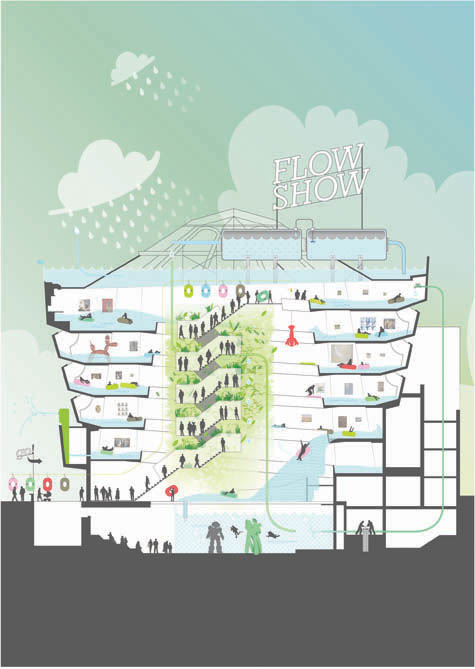 [Image: Flow Show by WORKac (2009)].
[Image: Flow Show by WORKac (2009)].
For a forthcoming exhibition called Contemplating the Void, New York's Guggenheim Museum "invited more than two hundred artists, architects, and designers to imagine their dream interventions in the space."
- In this exhibition of ideal projects, certain themes emerge, including the return to nature in its primordial state, the desire to climb the building, the interplay of light and space, the interest in diaphanous effects as a counterpoint to the concrete structure, and the impact of sound on the environment.
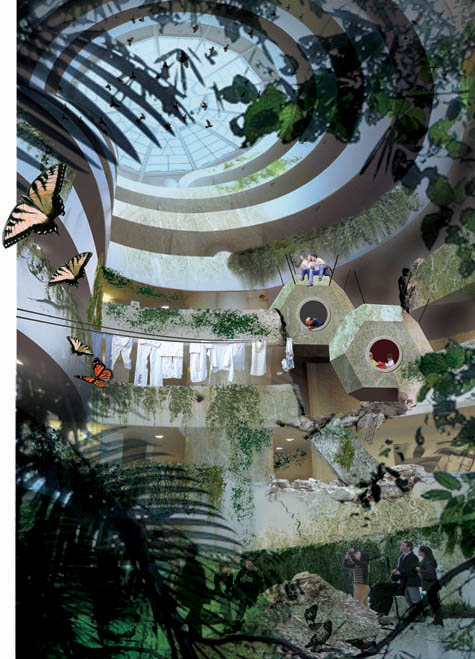 [Image: Untitled by N55 (2009)].
[Image: Untitled by N55 (2009)].The interior is taken over by coastal rain forests; there are mystical arabesques of colored music wrapping upward in spatially impossible curls through the museum's disappeared roof; there are trampolines and climbing nets strung from wall to wall above the lobby.
The Museum of Simulated Suicides, you could call it, where go to experience what it might be like to throw themselves into the void. You get a certificate of survival at the end.
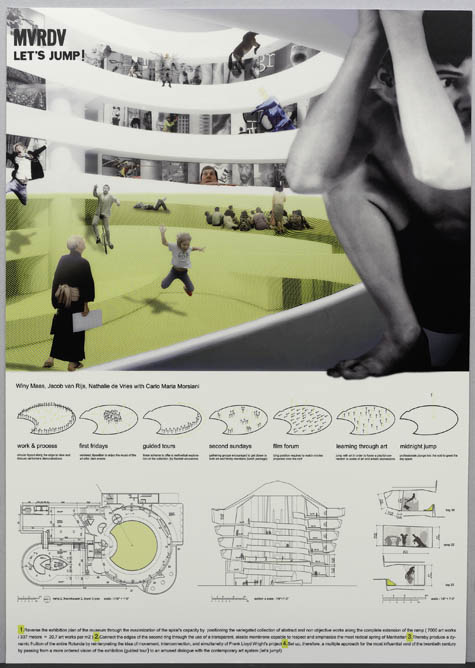
 [Images: (top) Let's Jump! by MVRDV (2009) and (bottom) Experiencing the Void by Julien De Smedt Architects (2009), the latter project also depicted in Agenda, pubished earlier this month].
[Images: (top) Let's Jump! by MVRDV (2009) and (bottom) Experiencing the Void by Julien De Smedt Architects (2009), the latter project also depicted in Agenda, pubished earlier this month].There are photo-collages and sectional diagrams of internally returning ecosystems.
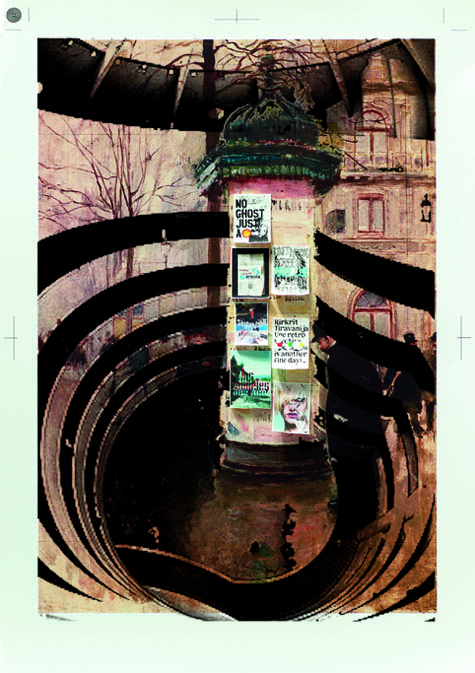
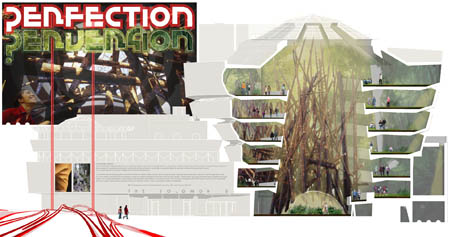
 [Images: (top) Morris in Guggenheim by M/M (2009), (center) Perfection_Perversion by West 8 (2009), and (bottom) The House of GI–A Proposal by Matthew Ritchie (2009)].
[Images: (top) Morris in Guggenheim by M/M (2009), (center) Perfection_Perversion by West 8 (2009), and (bottom) The House of GI–A Proposal by Matthew Ritchie (2009)].There are vast white balloons with visible structures trapped inside them rising out into New York's winter skies—
 [Image: State Fair Guggenheim by MAD Architects (2009)].
[Image: State Fair Guggenheim by MAD Architects (2009)].—as well as storms of red dust falling downward in a kind of gravitational pollution of the lobby.
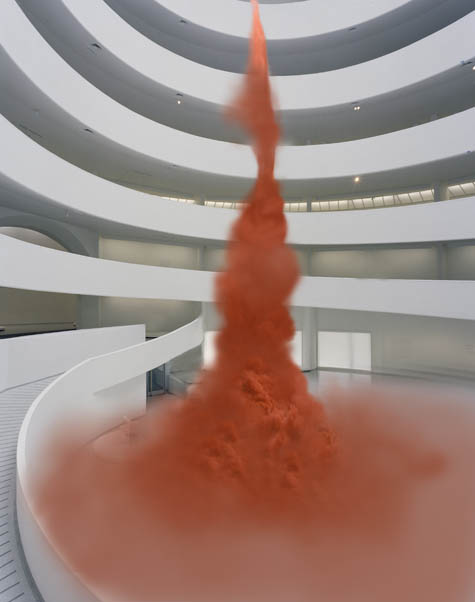 [Image: Untitled by Anish Kapoor (2009)].
[Image: Untitled by Anish Kapoor (2009)].Perhaps predictably, though, I might say an even better intervention into the Guggenheim's space is not a series of objects or architectural alterations at all, but an event—by which I'm specifically referring to one of 2009's most talked-about spatial moments, at least in architectural circles, when we see that very same museum annihilated in a hail of bullets in the film The International.
 [Image: A poster for The International featuring the Guggenheim Museum (2009)].
[Image: A poster for The International featuring the Guggenheim Museum (2009)].For all these calls for ideas and architectural design competitions, what if Hollywood set designers and location scouts are doing a more provocative job in non-preciously reimagining the inherited icons of the global built environment than 21st century architects?
These and many other images will be on display when the exhibition, Contemplating the Void, opens February 12, 2010.
![]()
So you thought you used to play 2D games. If you had taken a look behind the screen, then you'd have seen this. The featured game is Bubble Bobble from Taito, a classic 8-bit video game for the arcades and home computers, released in 1986.
Like many other Sevensheaven images this image is available as a high-quality art print. Visit the Sevensheaven shop portal for more info.
Och att sällskapet skulle springa långpass är väl inget hinder?
Inget halsont men dock några liter snor i näsan. Fast det har väl ingen dött av så det fick bli ett långpass i väldigt lugnt och behagligt tempo. Lugnt och behagligt för mig, så det var väl snarare tråkigt för sällskapet. Ja, för det är ju en han. Och inte vilken hanne som helst utan Martin och han är ju snabb.
Fast i ärlighetens namn undrar jag om det hade funkat att springa snabbare. I slottsskogen fick vi liksom trippa fram och även om det var lite bättre på övriga ställen fick man hålla koncentrationen på topp. Men det är säkert bra för något det också.
22,7 kilometer. 2 timmar och 15 minuter. Helt ok för en halkig tisdag i slutet av december.
In only my sixth full year of running (for the sake of running), 2009 has easily been my biggest, most successful and most satisfying. Prior to this year, I had only once experienced the satisfaction of being the first to cross the finish line of a race (Heart Center of the Rockies 10k, '08). This year alone I won a total of seven races, easily beating any and all expectations I had going into the year, so I think it would be fair to label 2009 as something of a break-out year for myself (at the tender age of 34/35). A full break down of my finishing positions in the 23 races (416 miles) I ran go as follows:
1st: 7
2nd: 5
3rd: 2
4th: 4
Other: 5
Much of my competitive success this year has come from running in smaller fields against local runners, but even admitting that, I'll give myself some credit for being consistent across a broad range of distances, while also maintaining a consistently decent level of fitness throughout the year - meaning that when fields were weak I could capitalize.
I am well aware of where I stand in the grand scheme of things on the running hierarchy (especially on roads, where there is no hiding from the black and white of finishing times), but being able to race at the head of a field, no matter its size or talent, has added a new level of fun to the process for me.
Some runners compete almost exclusively against the clock, and that is fine, but truth be told I much prefer the heat of battle than I do the satisfaction of a new PR. With that in mind, I look forward to continuing a few rivalries that have developed this year and last, while also stirring up a few more. In addition, I am anxious to run a few races again in 2010 that I felt went sub-optimally for me in '09, the most notable of which is the race on Manitou's Big Hill - this time up and down.
With regards to times, I set a bunch of new personal records this year, some by hefty margins - suggesting that I am still on the steep section of the improvement curve (for now) - although I suspect the curve will begin to level off in 2010, but I do hope that I have a couple more years of continued improvement before age begins the slowing process regardless of the effort I put into training. Here are the personal records I achieved this year:
5k: 17:19 (split for the 10k at Harrietsham in December. I consider this to be at least 40 seconds soft).
4 mile: 22:00 (Thanksgiving Day Run).
10k: 34:48 (Harrietsham 10k in December. A reasonably solid PR, although it was run on the back end of back-to-back 100-mile weeks).
Marathon: 2:43:35 (Dublin).
50 mile: 7:03 (Collegiate Peaks).
** I didn't win a single one of the races I PR'd at.
My half marathon PR was set three of four years ago in the 1:23 range, so that is a target for 2010, as is my 5k PR which I hope to bring down to 16:30 or lower in the first half of 2010. I would also like to find a fast 50 miler to run (maybe AR50) to set a PR there. Other than that, my races were largely at altitude and on mountainous singletrack courses, where the only real measure is previous course-and-distance times. Those races that I did run for a second time this year were all considerably faster than previous efforts.
At times this year, I have felt a bit short changed at getting into the sport so far advanced into my prime competitive years, but then I think back to the fun I had playing rugby and other team sports as a kid, and I realize that I probably wouldn't change a thing - other than the hatred I had for running as a training tool, and a few years in my middle 20s where I achieved little to speak of with regards to health and fitness. I also try to remind myslef as frequently as possible to quit whining and understand how fortunate I am to even have the freedom, health and desire to get out and do what I do on a daily basis.
I plan to train hard in 2010 to continue to make the most of the time I do have left to run to my body's full potential. As such I have set some pretty lofty goals for 2010, which I won't go into here, but suffice to say that Bandera is one of a few stepping stones towards the goals I have set.
Thanks to all who have offered advice, encouragement (here or elsewhere), company on the trail, inspiration and laughs over the course of the year. Running is a solo endeavor, but I find it to be a whole lot more fun when shared with good friends - old and new alike.
See you on the trail ....
Halsen känns ungefär som normalt idag så om de inte blir värre igen under dagen blir det nog spring enligt plan i eftermiddag. Fast först måste jag jobba lite. Dock bara fram till två, vilket känns otroligt skönt. Jag har faktiskt ett sällskap här hemma att ta hand om.
Appropå sällskap är det lyxigt att få maten serverad när man kommer hem. Så vill jag alltid ha det.
Temporary lakes have sprung up all over Manhattan again this week, sometimes more than twenty feet wide and a foot deep, spanning curbs and pooling in gutters, the aquatic remains of last week's rain and snowmelt. 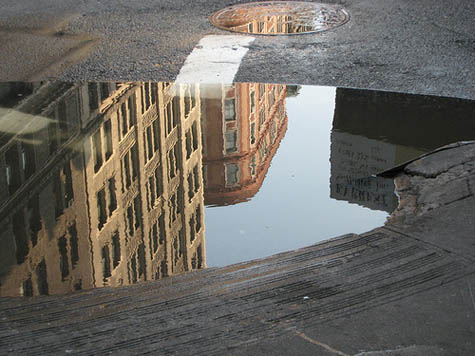 [Image: Photo by Flickr-user ShellyS].
[Image: Photo by Flickr-user ShellyS].
This surprise limnology—often demanding new, indirect lines of approach from one side of the street to the next—reminded me of David Gissen's recent, recommended book Subnature, which includes an entire chapter on urban puddles.
"Although we often think of puddles as inconsequential," Gissen writes, "they appear in architectural history in prominent ways—in drawings of ruins, photographs of decaying buildings, and experimental designs that attempt to use water in provocative ways." Now, however, "these stagnant pools of water, once signifying society's vulnerabilities, appear to have disappeared in much contemporary work"; indeed, he adds, contemporary architects have seemingly always "viewed stagnant water with suspicion." There is good medical reason for this suspicion, of course; indeed, the Centers for Disease Control advised last year that "neglected swimming pools"—i.e. stagnant bodies of water—are fast becoming vectors for mosquito-borne disease.
The CDC specifically cites "the adjustable rate mortgage and associated housing crises" as unexpected disease incubators: "Associated with home abandonment was the expanding number of neglected swimming pools, jacuzzis (hot tubs), and ornamental ponds. As chemicals deteriorated, invasive algal blooms created green swimming pools that were exploited rapidly by urban mosquitoes, thereby establishing a myriad of larval habitats within suburban neighborhoods," they wrote.
In any case, Gissen describes "visions of the undrainable city" as a kind of sickly counterpart to the modern, infrastructurally managed, rational metropolis, pointing out that "the waters inundating the modern city rained from above and surged from below." These overload our modern streets and sewers, bringing even 21st-century cities closer to the flooded Roman basements of Piranesi than to the hygienic visions of Le Corbusier, Gissen suggests. I'm reminded here of a disconcerting remark made by Alan Weisman in The World Without Us that the subways of New York City would be irreparably flooded within only 36 hours if the city's underground pumps ceased to function.
While reading Gissen's chapter on puddles, however, one of the first things that came to mind is that someone should produce a puddle map of New York—an urban atlas of temporary flooding. Set your parameters—puddles one foot deep by thirty-feet wide, say, or, more accurately, a volumetric guideline (at least one hundred square-feet of water or no less than 120 gallons)—and bring these fleeting aqueous forms into the geographic consciousness of the city. 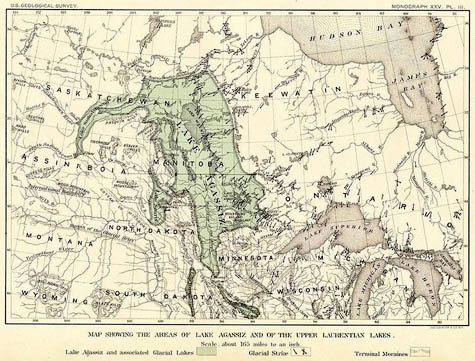 [Image: A map of glacial Lake Agassiz].
[Image: A map of glacial Lake Agassiz].
From one rainy season to the next, an accelerated paleolimnology of New York thus comes into being; the Lake Lahontans and Lake Agassizs of the five boroughs are given their cartographic due. Here a tiny lake once stood, historical plaques could read, bringing to mind a liquid version of Taylor Square, the famed "smallest park" in Cambridge, Massachusetts.
What monstrous puddles have existed in your neighborhood, and how have the urban circumstances of their existence changed over time? Did curb-cuts or new drains eliminate these hydro-geographies—or even make them worse? And whose lives have been affected by these unmapped bodies of water, whether through hydroplaning, sidewalk splashes, or even an expensive pair of ruined shoes?
Whole personal histories of human contact with puddles, and the effects such exposure might have, could be produced or recorded. This is extraordinary: we live beside temporary lakes and inland seas in cities all over the planet, yet these landmarks never make it onto our maps.
Redan igår kände jag de första små tendenserna. Inatt vaknade jag med djävulskt halsont och konstaterade att någon morgonjogg inte vara att tänka på. Två timmars sovmorgon blev det istället och nu gör det inte riktigt lika ont. Men vilodag blir det såklart ändå, så idag dricker jag honungste hela dagen (förutom att handla mat, stressa lite och jobba till sen kväll då.)
Inte någon snö idag heller, men det har åtminstone slutat regna. Det är inte särskilt ofta jag ogillar Göteborg, men när man sett hur fin vintern kan vara och kommer tillbaks till detta elände vill jag flytta på stört.
Hoppas ni får en bra och vit dag!
Tänk om det kunde få vara såhär hela vintern!
 [Image: Perspective by Jan Vredeman de Vries; no explicit relation to this post].
[Image: Perspective by Jan Vredeman de Vries; no explicit relation to this post].
Writing about the human experience of night before electricity, A. Roger Ekirch points out that almost all internal architectural environments took on a murky, otherworldy lack of detail after the sun had gone down. It was not uncommon to find oneself in a room that was both spatially unfamiliar and even possibly dangerous; to avoid damage to physical property as well as personal injury to oneself, several easy techniques of architectural self-location would be required.
Citing Jean-Jacques Rousseau's book Émile, Ekirch suggests that echolocation was one of the best methods: a portable, sonic tool for finding your way through unfamiliar towns or buildings. And it could all be as simple as clapping. From Émile: "You will perceive by the resonance of the place whether the area is large or small, whether you are in the middle or in a corner." You could then move about that space with a knowledge, however vague, of your surroundings, avoiding the painful edge where space gives way to object. And if you get lost, you can simply clap again.
Ekirch goes on to say, however, that "a number of ingenious techniques" were developed in a pre-electrified world for finding one's way through darkness (even across natural landscapes by night). These techniques were "no doubt passed from one generation to another," he adds, implying that there might yet be assembled a catalog of vernacular techniques for navigating darkness. It would be a fascinating thing to read.
Some of these techniques, beyond Rousseau and his clapping hands, were material; they included small signs and markers such as "a handmade notch in the wood railing leading to the second floor," allowing you to calculate how many steps lay ahead, as well as backing all furniture up against the walls at night to open clear paths of movement through the household.
Entire, community-wide children's games were also devised so that everyone growing up in a village could become intimately familiar with the local landscape.
- Games like "Round and Round the Village," popular in much of England, familiarized children at an early age to their physical surroundings, as did fishing, collecting herbs, and running errands. Schooled by adults in night's perils, children learned to negotiate the landscapes "as a rabbit knows his burrow"—careful after dark to skirt ponds, wells, and other hazardous terrain. In towns and cities, shop signs, doorways, and back alleys afforded fixed landmarks for neighborhood youths.
But this idea, so incredibly basic, that children's games could actually function as pedagogic tools—immersive geographic lessons—so that kids might learn how to prepare for the coming night, is an amazing one, and I have to wonder what games today might serve a similar function. Earthquake-preparedness drills?
In any case, we return to Rousseau. We see him advancing, now, heading forward into unknown architecture, dark space enveloping him on all sides, the walls fading into obscurity, black, leg-breaking stairwells threatening in the distance, unsure of where he stands, entirely alone in this shadow... until we hear a series of claps. And then another. Then one more.
And the philosopher, echoing himself, finding comfort and location based on objects he can't see, soon works his way out of the labyrinth.
So I capped my last week of training before the taper for Bandera with 100+ miles and two shorter-distance races. The legs were a bit sore from the effort at Saltwood yesterday and the week prior, but they also felt a little lighter during the race than they did yesterday, so I felt like I'd be able to give a PR a reasonably honest shot. I ran the race in 36:29 last year after posting a 17:20 out and 19:09 back (ouch), and have run 35:30 (short course ~6.1 miles) since. Based on recent races, I figured that a sub-35 would be a reasonable goal.
The course at Harrietsham is all pavement and pretty challenging for a road race, with rolling hills on much of the route. The out has a net drop, while the return has a net climb, with the nastiest hill left for the last kilometer.
Although there were only 350 runners in the field, the tone was way more racing focused than the festivities from yesterday. My brother had looked at the start list and informed me that a few of the guys from Tonbridge Athletics Club were likely to run sub-32, so I knew I'd be in the chase group, but hoped that I'd have a couple of guys to race with.
Got out for a short warm up with my brother then headed to the start by the church. Gun went off and I managed to keep from bolting, settling in behind a pack of 10-12 guys through the very early going. The pace felt good. By the first kilometer (they mark kilometers in 10k races in the UK, not miles as they annoyingly do in the US), I was 10-20 meters behind the lead pack of nine guys with two guys close at hand in front of me, so 12th after a first split of 3:09 (31:30 pace)! I was pretty confident there would be some carnage in front of me with that many guys at that pace, so I settled in, got comfortable and waited.
The next two splits came in at a more reasonable 3:23 & 3:35, which was approximately where I wanted to be, although I eased off a bit on the mental concentration through the third kilometer. I got a wake-up call from an Ashford AC runner who passed me somewhere here, and so set about re-establishing the 3:20s I wanted. The next two kilomenters were largely flat and came in at 3:28 & 3:42. I eased past the Ashford runner early and set about picking up the other two guys who had been running 10-15 meters ahead of me. I caught them both by the 5k split which posted at 17:19.
At the 5k last year (17:25), I tanked badly, and seeing the split this year I thought any hopes of going under 35 were unlikely given the course heads mostly up on the way back up. The sixth kilometer, however, had some very fast sections of drop where I was able to pick up a good head of steam, posting a 3:09 before settling in for the climb back out. With a figurative second wind kicking in and a nice literal tail wind blowing at my back, I felt strong and thought I might have a chance at picking off the eighth-placed guy who was a good 20 meters ahead of me. Kms 8 & 9 came in at 3:28 & 3:21, and just as I passed the 9k marker, I caught my final target for the race, slipping into eighth. The total split up to 9k was 30:48, so I figured I had a very good shot at going sub-35, despite the one nasty hill left to climb.
Knowing this was the last race of the year, and the last one before Bandera, I wanted to finish on a mentally and physically strong note, so I pushed the whole way in and crossed the line in 34:48 for a PR of over a minute. I'll take it. The most encouraging aspect of the race for me was my strong second half which I ran just nine seconds slower than the first half, despite the extra climbing and fatigue.
My brother, who said pre-race that he'd be happy to go under 40 minutes finished in 39:59.6!
Time to rest up for two weeks to get ready for 62 miles of rolling, rocky gnarliness in Hill County Texas. After a strong week, I feel ready to give it my best shot.
Monday
AM - 10.5 miles easy to Blean Woods (black loop) and back. 1:20.
PM - 6.5 miles easy. 53. Four university laps.
Tuesday
27.5 miles. 4:00'ish. Stour Valley, Saxon Shore Way, Crab and Winkle.
Wednesday
AM - 6.5 miles easy at Blean Woods. 60 mins. Red loop and green loop. Trails were sheeted with ice. Not much fun.
PM - 5 miles easy. 39 mins. Three university loops.
Thursday
AM - 17 miles easy. 2:23. Blean Woods Full Monty. All five way-marked trails: black, red, green, brown, white. Legs were pretty tired towards the end of this one.
PM - 6.5 miles easy. No watch. Four university laps.
Friday
AM - 10.5 miles easy to Blean Woods (black loop) and back. 1:22.
Saturday
Noon - 5 miles. 2 mile warm-up, then BDR race.
Sunday
AM - 8 miles, w/ 10k race (34:48).
Total: 103 miles (maybe 3,000' climbing).
Solid week with a very encouraging 10k on Sunday to cap it all off. Nothing better than feeling strong late into a tough race when you've already been worknig hard through the early going. Two much lighter weeks upcoming to rest the legs before the trip out to Texas.
The end of the year is rolling in and so am I. Rolling that is. It might be an exaggeration, but only slightly. Looking at the Christmas photos I was (and still am) horrified. Seriously whose fat face is that grinning back at me?
Wait.
It's mine.
Strange how when I dash on the make up at home, or snatch a glance in the mirror as I fly out the bedroom door I don't think I look that bad. But the camera never lies. And there were several cameras there on Christmas Day and they all showed the same thing.
Now I've made many plans for 2010, things like getting my bronze medallion, running a half marathon, that kind of thing. And being several kilos overweight is only going to make those things harder.
So for the next week I am going to be hell to live with.
Hell.
I always find the first few days of readopting a healthy way of eating insanely hard.
You know, the afternoon time where you are tired, so crackers and dips just helps you get through it. Evening time where something sweet goes down a treat. Those times.
But I'm approaching this differently.
This time I'm NOT weighing myself.
I'm not even going to get on the scales.
Not once.
Instead I'm setting goals like wanting Obama arms. You know. THOSE arms. I want a toned stomach and I want to wear short skirts again. Mostly though I want to weigh less so I don't have so much baggage to drag around when I do the half marathon. and I'm secretly thinking maybe I'll aim for the WHOLE marathon, maybe
I'm going to look back in a couple of months and cringe at THOSE Christmas photos and smile at the news ones taken of me where I look ( and feel) good.
I am going to take my measurements and recheck those each month. You see I think that maybe this is where I've been going wrong the past, oh twenty years or so. I've always thought that if I got down to a particular number on the scales, the door to happiness would magically open and maybe Dolce and Gabbana would choose me as their muse.
Well I didn't think the second bit, but certainly the first part.
But the thing is. My door to happiness IS open. And even if it wasn't, I owe myself better than this. So rather than thinking in terms of numbers, I'm thinking of specific things I want for my body, to make it great for me.
So in a way that's my new year's resolution though I'm starting early, because really, there is never a good time to start.
I know lots of people don't make resolutions and I simply don't get that. I'm not being judgemental if you don't. I'm just the kind of person who sees it as a way of setting new goals for myself and making sure I do them.
And I can't do it without support.
My husband is an unwitting accomplice in this endeavour, and in a way, so are you dear reader.
And out of curiosity, do you make resolutions and if so, what's yours?
xxxxx
Today we celebrated the Day of Boxes by heading out to the village of Saltwood for the Boxing Day Run - a three-mile cross country race I've done with my family for the last four years.
For those unfamiliar with Boxing Day, it is a national holiday in the UK which hearkens back to a time when servants and other social inferiors received gifts from their masters and got a rare day off. These days, it's more about football, beer and silliness, which probably explains why close to a 1,000 of us jam into the small village of Saltwood every Dec. 26 in the cold and rain to run through the thick mud of the Kentish countryside.
True to the nature of the holiday, the run is more about having a laugh and raising money for charity than it is about getting out and being competitive. The organizers, much like the day and the race, are a bit haphazard and never fail to amuse with the manner in which they're unfailingly overwhelmed by the task of timing the large numbers that always seem to take them by surprise. This year they were trying out a revolutionary barcode system to time the 1,000 or so assembled - more on that later.
My brother had his three kids (8,6 & 4) signed up to run, and Thomas - the eldest - was determined to beat our friend Jim this year after some gentle prodding from his uncle and dad, and a solid 26:30 recent 5k. Upon seeing Jim before the race in the pub, Thomas informed Jim of his intent and had nothing else to say before we headed off to the start, which had been relocated from the village green to the school playing fields.
After clearing the first big field, the course narrows on to a footpath and then back out to another smaller field before coming to a one-man-wide footbridge and the first fence/gate, where I was sitting in fifth and running comfortably behind three and four.
I was after a podium finish this year, and at this stage it seemed like I was in the hunt, with the three of us gapped behind second and also gapped to the pack behind. I chose to take the swing gate after the bridge rather than hurdle the fence, as the mud was so deep on the other side I was fearful that my shoe would be sucked off if I planted too hard in the slop. Working up the hill to the second fence crossing, I stuck behind the two guys ahead of me wishing desperately that I had a pair of spikes on, as the footing was just ridiculous. I had a pair of Sportiva Crosslites on, which, while decent in the mud, are no match for the traction that spikes can offer in the slop.
Once we cleared the hill and started across the biggest of the fields, I could sense that the two in front of me were either hurting or easing off a bit to recover from the hill, so I upped the pace to slip into third at the turn towards the woods, which is probably about the halfway point.
The wooded section is definitely my favorite section of the course, and today it offered by far the best off-road traction of the whole race. There is a quick drop as you get through the swing gate into the woods and I opened it up fully here to see if I could get a gap on the sodden but leafy trail section, and indeed I did, although it was short-lived as the slop soon returned and I was re-overtaken by my spike-wearing competition for third. He sounded like he was working hard so I was pretty confident that he wouldn't last.
Out of the woods, we continued almost shoulder to shoulder up the edge of the last field before I decided to try and get a lock on third by pushing as hard as possible on the last hill, which offered a pebbled and blissfully textured section of footpath, before hammering the drop to the final turn on to the road which leads back into Saltwood and the finish line.
As I made the turn, with a quarter mile to go, I shot a quick glance over my shoulder and saw that the guy I had been dueling for the last two miles had dropped about ten meters back. While he didn't look like he was giving up on third, I figured I had it in the bag. Error. About halfway through the final stretch, the spectators began to get very animated, and I realised that I was going to have to break out a full-on sprint to keep third.
However, with 90 miles in my legs from the five days prior I just couldn't pick up my knees. In fact, I even heard someone shout at me to pick up my knees, but I just couldn't find it and I was out-kicked and overtaken in the last ten to fifteen meters. I finished in 17:50, which is a about a half minute slower than last year, despite the fact that I'm probably a minute fitter. Tough conditions.
If I could have done it all over, I probably would have worked harder through the middle sections and not left it so late, as I quite simply don't have the leg speed for sprint finishes in these shorter races - I guess I'm more of a strength runner. One of these years I'm going to pick up some hardware from Saltwood - maybe in the new decade.
The timing? Another year, another fiasco. As I mentioned earlier, we had barcodes on our bibs this year. Unfortunately, however, the guy who was supposed to bring the equipment to process the barcoded bibs was a no-show, so the poor organizers had to scrape around at the last minute and ended up resorting to the funnel method for which they seemed woefully unprepared. When the main pack was back at the finish, the bottleneck through the funnel was probably thirty meters back, and extending way beyond the finish line into the last ten meters of the course. We'll see how many make it into the final results.
At the end of the day though, I don't think anyone really cares too much about the results and the timing, and those that do can time themselves. I don't know any other race that can charge so little (£5/$8), give away a medal to all finishers and still donate over £3,000 ($5,000) to charity.
Thomas failed in his quest to beat Jim, but still had a good run. My brother ran a solid race close to his time from last year - but was chicked by at least two, maybe even three, ladies. The winner in the women's race, Grace Nicholls, ran a very impressive race coming close to the course record (in the mud). Turns out she was fifth in the U-19 Cross County Nationals this year.
Six-year-old William had a great run with his mom, while four-year-old Maddie was a bit too sick to run. Alistair enjoyed his race morning, as ever, getting out for a short romp around the school fields with his mom.
I'm running a 10k in Harrietsham, near Maidstone, tomorrow to round out a great season of running. I'm hoping to finish out the decade by PR'ing and dipping under the 35-minute mark. We shall see.
Best audio quality (IPlayer)
Audio
Kode 9 & The Spaceape - Ghost town - Hyperdub
Coconami - Sleigh Ride - Trikont
King Midas Sound - I man - Hyperdub
Martin Rev - Jubilate - Blast First Petite
Solomonic Reggae Star - Solidarity - Dub Store Records
Pablu Gad - Blood suckers dub - Reggae on Top
Rico - Dial Africa Dub - Island Records
Manasseh - SoulJah - London Street Beats
Welders - Laboring - Bopaganda
Group Bombino - Guitars from Agadez vol.2 - Sublime Frequencies
Bo Diddley - MY White Horse - Chess
Group Doueh - Tazit Kalifa - Sublime Frequencies
Pax - Sittin' on my head - Vampi Soul
Jean-Pierre Massiera - Jingle Jungle - Mucho
Vieux Farka Toure - Wale - Six Degrees
Mulatu Astatke - Cha Cha - Strut
F*ck Buttons - Surf Solar - ATP -
M.Ward - Never Had Nobody Like You - 4AD
Haddenham One Orchestra - Bodmix (Mrs Cakehead Wonky Dub) - Pumf Records
The Fully Celebrated - Drunk on the blood of the holy ones - AUM
The Embassadors - Sierra Alone - Intiative Musik
Staff Benda Bilili - Sala Keba - Crammed Discs
John Teo and the Stylers - Riding a Trishaw around China Town - Sublime Frequencies
Cornfed Four - Let the Church Roll On - Document
Jesse Fuller - Sleeping in the Midnight Cold - Feld
Llyod Miller - Gol-e Gandom - Jazzman
Egentligen borde det suttit en bild på ett väldigt vackert och vitt Arvika här, men eftersom jag inte fotat något (och nu är det ju mörkt) får jag visa imorn. Det började snöa igen igår eftermiddag. Lagom till att jag skulle ut på fartleksspring kom det vassa små flingor. (Fartleken gick väl inte nåt vidare direkt. Det är svårt att få till någon vidare kvalitetslöpning när man bara kanar runt u snömodd.) Lagom till att vi skulle åka taxi in till stan lite senare på kvällen kom det lite större flingor. När jag kom ut från utestället var det vitt precis överallt. Megastora vita flingor landade på en mycket snöfylld mark. I förmiddags (när jag vaknat till liv, varför går det aldrig att ta det lite lugnt med vinet på juldan?) var det ett 3,5dm tjockt lager som mötte mig. Så härligt! Nog för att det är segt att springa i snö, men jag hade gärna tagit med mig åtminstone hälften ner till gbg när jag åker imorn kväll. Så himla vackert att det nästan gör ont.
Anledningen till att jag hade planerat att vara icke-bakis idag stavas gästinstruktör. Som tur var försvann bakisheten efter lite mat och en ipren och gänget som kommit för att testa army training fick se en rätt representabel Andréa. Jag kom in i min instruktörsroll och peppade till utmattning. Grymma var de, och jag tror de vill köra igen någon gång vid tillfälle då jag är hemma. Roligt!
There's an interesting article on the BBC News site this week about the mystery of the Amazonian Manatee's migration habits.
Only in recent years did scientists find that the secretive aquatic mammal migrates from shallow to deep water.
Now researchers can reveal that the manatees make this perilous journey to avoid being exposed to attack by predators during the low-water season.
That means the species may be at greater risk than thought, say scientists, as migration and low water levels make them vulnerable to hunters.
The international team of researchers from Brazil and the UK publish their findings in the Journal of Zoology.
Last Sunday, 12/20/09, I couldn’t get out of bed. Steph let me sleep in until she and Maya came to say “Good Morning” around 8:30 AM. I got out of bed, went to the kitchen for breakfast and found I had missed a call from my aunt. The message was short. “Dean, call me.” My heart sank. I knew.
Israel Sumner Saxe, my grandfather, passed away that cold, snowy morning in Boston, 12 days shy of his 91st birthday. He is survived by his wife of 68 years, Ethel, three children, five grandchildren and four great-grandchildren.
I last saw Grandpa over the summer, when Maya and I went to Massachusetts for a visit with my grandparents. At the time he was slowing down and in pain, but doing his best to enjoy life. That’s not how I choose to remember Grandpa. I remember him as a big, strong man who didn’t take shit from anyone and always told it like he saw it. A man who was loved by everyone who knew him.
My earliest memories of Grandpa are in Grandma and Grandpa’s house on Margaret Lane, playing with my brother and cousins in and around the pool. Fishing on Lake Massapoag in Sharon, MA and in the pond at Grandma & Grandpa’s condo on Cape Cod. Learning to shoot a pistol. Watching Grandpa cook breakfast for everyone at the Massapoag Sportsmen’s Club, which he founded in the 1950’s after being denied membership to another club because he was a Jew. Taking the ferry to Martha’s Vineyard. My favorite, and strongest memory, is watching Grandpa smoke his pipe, burning a sweet-smelling tobacco. The smell of his tobacco is indelibly imprinted in my head. To this day I think of him every time I see someone with a pipe or I smell pipe tobacco.
I spent the past few days with my extended family sharing stories about Grandpa and his life. Yesterday he was laid to rest at Sharon Memorial Park in Sharon, MA. Rabbi Jonathan Hausman presided over a moving service. As the pallbearers wheeled his casket to the hearse, I noticed that the funeral home was standing room only. Grandpa always said nobody would show up at his funeral, he had “outlived all of his friends,” in his words. By my estimate over 100 people attended on a cold Christmas Eve to say their final goodbye to a great man who touch the lives of so many people.
Standing at the gravesite in 37 degree Fahrenheit temperatures, surrounded by snow and ice, the Mourner’s Kadish was read. Before completing the final mitzvah (good deed) of burying his casket, his grandchildren, children and son-in-laws smoked Grandpa’s pipes filled with his favored vanilla flavored tobacco, filling the air with the sweet scent of pipe smoke in his honor. As we smoked, we performed the mitzvah, shoveling dirt upon his casket, filling his grave as we said goodbye. The first shovelful by each mourner is done upside-down, using the back of the shovel making it difficult to use, as a symbol of our reluctance to complete the task. Normally, the family and assembled mourners shovel a small amount of earth into the grave; the cemetery groundskeepers complete the remainder of the work. In an act of love, kindness and ultimate respect the gathered crowd remained under cold, overcast skies, family and friends each taking part in the mitzvah until his grave was completely filled.
This week has been one of the most difficult of my life. I am finding it hard to believe that I won’t speak with him again; I won’t Skype with him again to show him how Maya is growing up. He is gone, but he is not forgotten. At the funeral, I was handed a videotape of interviews conducted in 2004 with Grandpa to share stories of his life, particularly focused on his family’s emigration from Poland in 1924. (Ukraine? The fluid borders in that area in the 1920’s make it difficult to determine without more research.) My aunt found an audiotape of interviews starting in 2004 where Grandma and Grandpa attempted to verbally document their lives. In the next few weeks I hope to have digital replicas of these to distribute to our family. I have resurrected my work on my family tree, a project I began when Maya was born. Grandma was instrumental today in providing information about his relatives and hers. My grief will be turned into work to preserve our family history for those who remember my Grandpa and those who never had the pleasure of meeting him.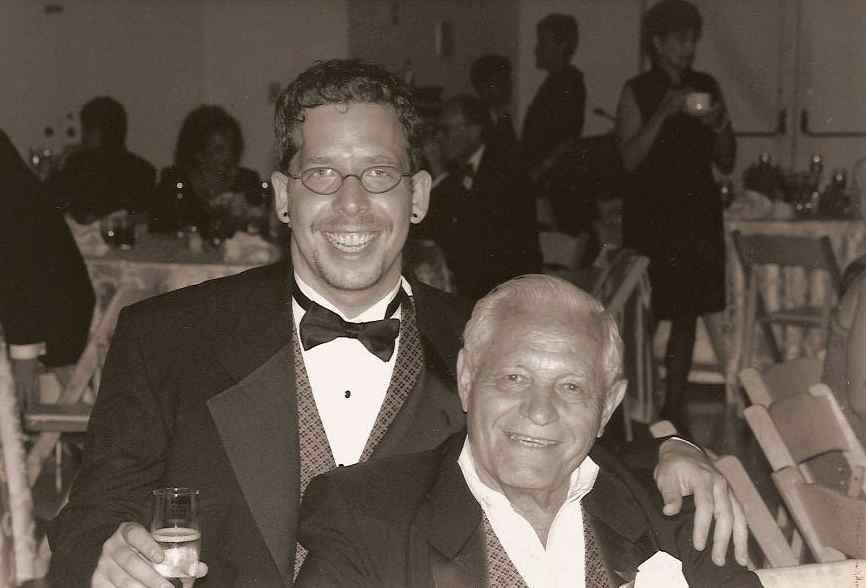
Israel “Sumner” Saxe
January 1, 1919 – December 20, 2009
עליו השלום (alav ha-shalom)
Peace be upon him
Lưu trữ Blog
-
▼
2009
(1255)
-
▼
tháng 12
(126)
- Happy New Year Everybody
- Kakapo Artificial Insemination a 2009 Success
- Gott nytt år!
- It's the last day
- Art Trap
- Spiral Icon
- Inside Bubble Bobble
- Varför börja lagom när man kan börja med sällskap?
- Racing Year in Review
- Halsrapport
- Manhattan Paleolimnology
- En hals som förstör
- Kontraster
- Rousseau and Echolocation
- Harrietsham 10k
- Week Ending Dec. 27
- Re-shaping
- Sluggish and meandering
- Saltwood Boxing Day Run
- Playlist - 26th December 2009
- Snöigt
- Mystery of Amazon Manatee Migration Solved
- In Memoriam
- The Shining movie poster
- Min julafton
- Music for Landscapes
- God jul!
- Julen är här
- Merry Christmas and have a cup of Civet Poo!
- Jeez Louise and Thomas Sabo
- På plats i värmlandsskogen
- East Kent Sea and Countryside
- Merry voXelMas!
- Banana flavoured Cinnamon Chips Mmmm!
- Across the ocean
- Julledig!
- Stephen Fry on Operation Rhino
- The Ducks gave Cate the cold shoulder
- Leviathan: An Interview with Richard Mosse
- Geospatial Holograms
- En vit jul?
- Muscatatuck
- The Burj Dubai as Storm Machine
- Week Ending Dec 20
- Både bra och dåligt
- Crash State
- Dance and show us your miracles!
- Playlist - 19th December 2009
- Med solen i ögonen
- On Bombs and Preservation
- VIERNES
- A User's Guide to New York City pt. 2: Street Vend...
- A User's Guide to New York City pt. 1: Tenants' Ri...
- And the winners are!!!!
- Don't skip in Landstrasser-Hauptstrasse
- Technabob logo redesign
- Overweight
- Recent Site Change
- A PHOTO STORY BY REED + RADER
- An Ocea of calm
- Merry Christmas !
- THE FIRST DAYS OF SPRING - A FILM BY NOAH AND THE ...
- China, Iran, Myanmar, Australia
- CANDIE - POSITIVE MAGAZINE
- PHOTOGRAPHY OF GALA COLLETTE
- WASHED OUT - BELONG VIDEO
- PHOTOGRAPHY OF SANDY KIM
- Best New Blogs of 2009
- Love in the Time of Home Quarantine
- Pica-sso
- Napoleon did not have this much trouble!
- They might be Golden Crowned Hornswoggles
- Cracking the Planet
- Pirate Radio Speleology
- And a little child shall lead them (and my giveaway!)
- Christmas Classic 4 Miler
- Week Ending Dec 13
- Playlist - 12th December 2009 - Funkology
- HOT CHIP - ONE LIFE STAND
- ART OF COREY SMITH
- Editorial cartoons
- We would like to talk to you about the bible
- Northern White Rhinos Returning to Africa?
- Blog catchup time
- HEALTH LIVE VIDEOS AND INTERVIEW
- It's time to Butt Out
- Ninja christmas
- MEMORYHOUSE - TO THE LIGHTHOUSE
- CANDIE - STIMULUS RESPOND "SKIN"
- Eat the Earth
- PORTISHEAD - CHASE THE TEAR
- When a door closes
- TIMES NEW VIKING - BORN AGAIN REVISITED
- Get the Rat Hat ready
- Blackout
- Don't stand during the Messiah
- Make Mine a Minaret
- How To: Seed Grenade
- Welcome to the Sultans Suite
- Agenda
-
▼
tháng 12
(126)
















.jpg)



.jpg)
.jpg)


